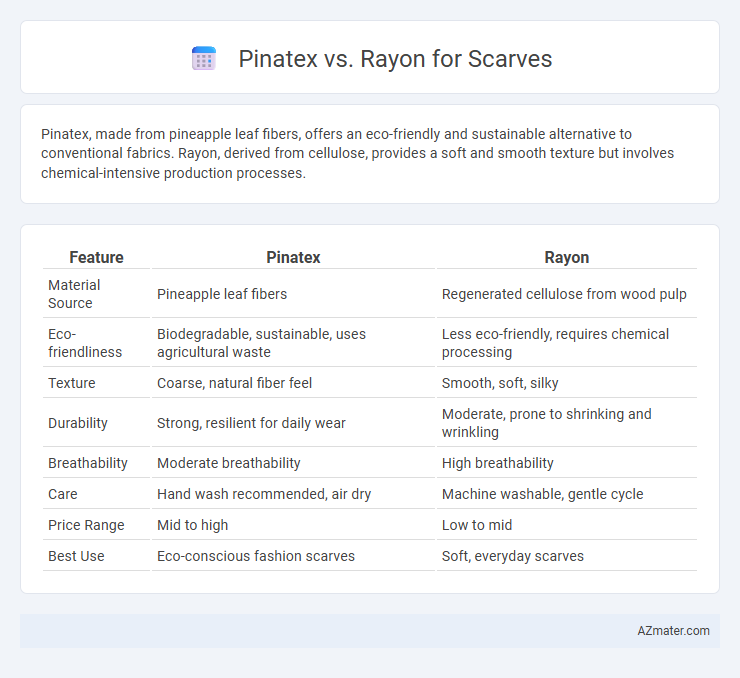Pinatex, made from pineapple leaf fibers, offers an eco-friendly and sustainable alternative to conventional fabrics. Rayon, derived from cellulose, provides a soft and smooth texture but involves chemical-intensive production processes.
Table of Comparison
| Feature | Pinatex | Rayon |
|---|---|---|
| Material Source | Pineapple leaf fibers | Regenerated cellulose from wood pulp |
| Eco-friendliness | Biodegradable, sustainable, uses agricultural waste | Less eco-friendly, requires chemical processing |
| Texture | Coarse, natural fiber feel | Smooth, soft, silky |
| Durability | Strong, resilient for daily wear | Moderate, prone to shrinking and wrinkling |
| Breathability | Moderate breathability | High breathability |
| Care | Hand wash recommended, air dry | Machine washable, gentle cycle |
| Price Range | Mid to high | Low to mid |
| Best Use | Eco-conscious fashion scarves | Soft, everyday scarves |
Introduction: Piñatex vs Rayon for Scarves
Pinatex, a sustainable textile made from pineapple leaf fibers, offers durability and eco-friendly qualities ideal for scarves, while rayon, a semi-synthetic fiber derived from cellulose, provides a soft, silky texture but involves intensive chemical processing. Pinatex promotes ethical fashion with its biodegradable and plant-based origin, contrasting with rayon's reliance on chemical treatments and potential environmental concerns. Choosing between Pinatex and rayon for scarves depends on prioritizing sustainability and natural fiber innovation or comfort and traditional fabric feel.
What is Piñatex?
Pinatex is an innovative sustainable fabric made from pineapple leaf fibers, offering an eco-friendly alternative to traditional textiles like rayon. Unlike rayon, which is a semi-synthetic fiber derived from wood pulp and involves chemical-intensive processes, Pinatex utilizes agricultural waste to reduce environmental impact. Its breathable, durable texture makes it an ideal choice for scarves, combining sustainability with unique aesthetic appeal.
What is Rayon?
Rayon is a semi-synthetic fiber derived from cellulose, typically sourced from wood pulp or cotton waste, known for its softness and breathability, making it a popular choice in lightweight scarf production. Unlike Pinatex, which is made from pineapple leaf fibers and offers a sustainable, eco-friendly alternative, rayon undergoes chemical processing that can impact environmental sustainability. The choice between Pinatex and rayon for scarves depends on preferences for texture, durability, and ecological footprint.
Sustainability Comparison
Pinatex, made from pineapple leaf fibers, offers a sustainable alternative to conventional textiles due to its use of agricultural waste and low water consumption, reducing environmental impact compared to Rayon. Rayon production involves chemically intensive processes and high water usage, contributing to pollution and deforestation concerns. Choosing Pinatex for scarves supports circular economy principles and reduces reliance on resource-intensive, non-biodegradable materials like Rayon.
Texture and Comfort
Pinatex scarves offer a unique texture with a natural, slightly coarse feel derived from pineapple leaf fibers, providing breathable and eco-friendly comfort. Rayon scarves deliver a smooth, silky texture that drapes softly against the skin, ideal for those seeking lightweight and comfortable wear. Choosing between Pinatex and Rayon depends on the preference for textured, sustainable material versus silky softness and fluid comfort.
Durability and Longevity
Pinatex, made from pineapple leaf fibers, offers high tensile strength and natural resistance to wear, making it a durable choice for scarves that maintain their shape and texture over time. Rayon, a semi-synthetic fiber derived from cellulose, provides a smooth and soft feel but tends to weaken with repeated washing and prolonged exposure to moisture, leading to reduced longevity. Scarves crafted from Pinatex demonstrate greater resilience and sustained aesthetic appeal compared to those made from rayon, which are more susceptible to fiber breakdown and fading.
Breathability and Climate Suitability
Pinatex, made from pineapple leaf fibers, offers excellent breathability due to its natural cellulose structure, making it highly suitable for warm and humid climates. Rayon, a semi-synthetic fiber derived from cellulose, provides moderate breathability but tends to retain moisture, which can reduce comfort in hot weather. For scarf wearers seeking optimal airflow and climate adaptability, Pinatex stands out as a more breathable and eco-friendly choice compared to rayon.
Style and Color Options
Pinatex scarves offer a unique, textured aesthetic derived from pineapple leaf fibers, available in earthy tones and natural hues that emphasize eco-friendly style. Rayon scarves provide a smooth, silky finish with a broad spectrum of vibrant colors and intricate patterns, catering to diverse fashion preferences. Choosing between Pinatex and Rayon depends on the desired combination of sustainable material and versatile color variety for stylish scarves.
Price and Accessibility
Pinatex scarves typically cost more than rayon due to their sustainable production process and natural pineapple leaf fibers, which are less widely available than synthetic rayon materials. Rayon scarves are more affordable and accessible, benefiting from extensive manufacturing infrastructure and lower production costs. Consumers seeking eco-friendly options may find Pinatex scarfs pricier but worth the investment, while those prioritizing budget and ease of purchase often prefer rayon alternatives.
Piñatex vs Rayon: Which Is Better for Scarves?
Pinatex, a sustainable material made from pineapple leaf fibers, offers durability, breathability, and eco-friendliness, making it an excellent choice for scarves that require softness and longevity. Rayon, a semi-synthetic fiber derived from cellulose, provides a smooth texture and vibrant drape but involves chemical processing that can impact environmental sustainability. For scarves, Pinatex delivers a more sustainable and durable alternative to rayon, appealing to eco-conscious consumers seeking stylish yet environmentally responsible options.

Infographic: Piñatex vs Rayon for Scarf
 azmater.com
azmater.com